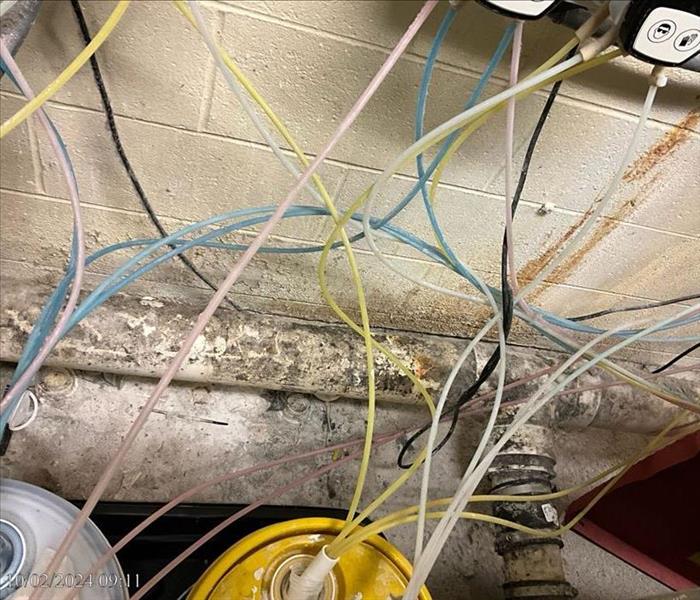Keeping Schools Safe from Mold Growth During Summer: Essential Tips for a Healthy Return
10/30/2024 (Permalink)
When summer break begins, schools enter a quieter period, with classrooms empty, lights off, and schedules on hold until students and teachers return in the fall. However, the absence of daily activity and routine maintenance during the summer months can create ideal conditions for mold growth. Mold thrives in warm, humid environments, making summer a prime season for potential mold issues if left unchecked. For school facilities managers, preventing mold growth during this period is crucial to ensuring a healthy learning environment when doors reopen. Here’s how to proactively protect your school from mold growth over summer break.
Why Mold Prevention Matters for Schools
Mold spores are virtually everywhere, but they only become problematic when they find moisture and warmth. Mold growth inside a school building can lead to:
- Health Concerns
- Structural Damage
- Disruption of Learning
1. Control Humidity Levels
Humidity is the single most significant factor in mold growth. Over the summer, warm temperatures and high humidity can lead to moisture buildup. By keeping humidity levels under control, you reduce the likelihood of mold.
- Run Dehumidifiers: In areas with higher humidity, consider running dehumidifiers, especially in areas prone to moisture like basements, locker rooms, and storage closets.
- Set Thermostats Properly: Although schools may reduce air conditioning usage to save energy, it’s essential to maintain a moderate temperature to prevent humidity buildup. A consistent temperature of around 78°F helps control humidity while balancing energy efficiency.
2. Identify and Repair Water Intrusions
Leaks or water intrusions are primary causes of mold issues in schools. Inspect your building for any signs of leaks or water intrusion before the summer.
- Check Windows and Doors: Ensure that windows and doors are properly sealed. Unsealed openings allow moisture from rain to seep into the building.
- Inspect Roofing and Gutters: Conduct a thorough inspection of the roof and gutters to ensure they are clear of debris and in good condition. Repair any leaks or blockages to prevent water from entering the building.
- Evaluate HVAC Systems: HVAC systems play a key role in managing indoor air quality and moisture control. Regularly inspect and maintain these systems to ensure they are operating efficiently and keeping moisture levels low.
3. Clean and Dry Damp Areas Promptly
Mold can begin growing on damp surfaces within 24-48 hours, so it’s critical to dry any moisture that accumulates promptly.
- Address Spills and Leaks Quickly: If any water spill or leak occurs, ensure it’s dried thoroughly and promptly, whether it’s on carpeting, concrete, or wood surfaces.
- Inspect Damp-Prone Areas Regularly: Locker rooms, bathrooms, kitchens, and basements are especially susceptible to moisture. Make a point of routinely checking these areas for dampness and taking measures to keep them dry.
4. Remove or Replace Damaged Materials
If building materials have previously experienced water damage, it’s essential to replace or properly treat them. Materials like drywall, carpeting, and ceiling tiles can harbor mold spores and promote mold growth.
- Inspect Frequently Used Areas: Regularly check high-traffic areas like classrooms, gyms, and hallways for signs of water damage or mold growth.
- Replace Compromised Materials: If you find any materials that show signs of mold, replace them with mold-resistant alternatives, which are designed to inhibit growth and withstand moisture better.
5. Create an Ongoing Mold Prevention Plan
Mold prevention is an ongoing process that requires consistent attention. Schools can benefit from a comprehensive mold prevention plan that outlines specific steps for regular inspection and moisture control.
- Schedule Routine Inspections: Establish a schedule for inspecting the building for leaks, dampness, or mold signs, focusing on high-risk areas.
- Train Staff: Educate custodial and maintenance staff on the signs of mold and the importance of reporting any potential issues immediately.
- Work with Professionals: Partnering with a mold remediation professional, like SERVPRO®, can ensure you have expert support and rapid response if any issues arise.
What to Do if Mold is Discovered
Even with careful prevention, mold may sometimes appear. If mold is detected, it’s crucial to act quickly. Mold remediation specialists can help by:
- Assessing the mold's extent and identifying moisture sources.
- Containing and removing mold-affected materials to prevent the spread.
- Restoring the affected areas to create a safe, mold-free environment for students and staff.
Stay Ahead of Mold This Summer
A proactive approach to mold prevention can help ensure that your school is ready to welcome students back in the fall. By controlling humidity, addressing potential leaks, maintaining cleanliness, and training staff, you’re investing in a safe and healthy learning environment. For expert support and peace of mind, reach out to SERVPRO for professional mold remediation and prevention solutions tailored to your school’s needs.




 24/7 Emergency Service
24/7 Emergency Service
